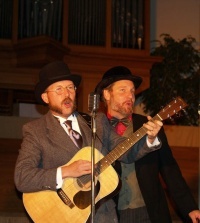c. 2008 Religion News Service
WASHINGTON _ In his carefully cocked black bowler hat, knee-length frock coat and wrap-around bow tie, Mark Scandrette, the preacher from another century, makes his sales pitch.
“Some balm in your palm will help you stay calm,” he bellows, placing heavy emphasis on the rhyme, as if even the most simplistic literary device is evidence of a higher power. “Good for the soul and great on your salad.”
Scandrette’s miracle healing Balm of Gilead is, in fact, neither miraculous nor possessing of any identifiable healing qualities. (It could more accurately be described, in layman’s terms, as extra virgin olive oil.) And Scandrette, despite appearances and advertisements claiming otherwise, is not a time traveler from the year 1908.
But his audience at American University is eating it up.
“We’re giving it a whoop!” Scandrette shouts.
They whoop.
“We’re giving it a push! We’re giving it everything we’ve got!”
Shouts of “Amen!” ring from the small bandbox of a chapel.
Part revival meeting, part play-acting, part book tour, the Church Basement Roadshow is a performance from the early 20th century recast with a message for the early 21st. Since early June, Scandrette, Tony Jones and Doug Pagitt have traveled the country in a biodiesel-powered RV, stopping to hawk bottles of healing balm and sell books, while pitching their idea of a postmodern Christianity.
The three time travelers are leaders of Emergent Village, an organization rooted in disillusionment with traditional Christian preaching. Emergent members follow a “generous orthodoxy” _ agreeing to disagree on specific theological differences while working to integrate broader Christian themes into modern culture.
Scandrette and his fellow travelers say their road show is just one way to spread what he calls “this benevolent virus.”
“I’m intrigued by the way social movements work,” Scandrette says. “Slowly, what becomes a backroom or side conversation really spreads like a virus through communities.”
On stage, the three revivalists don period garb from 1908, and attempt, in good humor, to recapture the spirit of early evangelists. Each has a different persona: Scandrette is the respected minister; Pagitt the fast-talking street preacher; and Jones the Plato-bashing theologian.
As the audience files in, a mix of trance music and Springsteen blares from the speakers. Volunteers collect donations in family-size Kentucky Fried Chicken buckets. And Pagitt roams the audience in character, hoping to find a trombonist to fill a bit part in the group’s finale song.
The costumes are meant to evoke the feel of an early 20th century revival meeting, when preachers would travel across the country in a flurry of fundamentalist fervor. Yet the road show’s message is a distant echo of its fire-and-brimstone predecessors.
Unlike the turn-of-the-century evangelists, whose calls for repentance Scandrette calls “brutish,” the basement Bible-thumpers offer up a free-wheeling gospel that stands in strict opposition to rigid orthodoxy.
(BEGIN OPTIONAL TRIM)
Swapping his professorial pipe and gray suit for a T-shirt and black-rimmed hipster glasses midway through the performance, Jones tells of a tyrannical Bible study leader he met while at Dartmouth College _ a self-proclaimed “discipler” who lumped the world into “believers” and “unbelievers.”
Pagitt, meanwhile, muses that people have a tendency “to create versions of Christianity that fit well in one environment but don’t fit well in another one.”
“Jesus,” he says, “doesn’t say the same thing to any two people.”
(END OPTIONAL TRIM)
Critics of the emergent church movement argue that it barely skims the surface of deep theological issues and offers insufficient answers to critical inquiries. Scandrette, however, says the movement draws value from its limitations.
“People (are) asking the question, `What does it mean to follow Jesus in the time and place that we live?”’ he says. “I think it’s important that it’s a question _ it’s not certain.”
As the show winds down, the three revivalists return to the stage for a final send-off. Jones is the pipe-smoking, guitar-playing, mutton-chopped professor; Pagitt has found a willing participant to take over on the trombone; and Scandrette makes one final sales pitch for his Balm of Gilead.
The audience _ a healthy mix of emergent church members, curious observers and students from nearby Wesley Theological Seminary _ is on its feet for the chorus. Hands clapping, bodies swaying, trombone blaring, the Rollin’ Gospel Revival comes to its full-throated conclusion.
“Jesus, Jesus, Kingdom of God revealed; Love is the way, we follow each day, and in him all is healed,” they sing.
The final product resembles a hybrid of Billy Sunday, Norman Vincent Peale and “The Soggy Bottom Boys,” the folk-singing troupe from the movie “Oh Brother, Where Art Thou?”
It’s a comparison the three are happy to embrace.
“We post-modern Emergent hipsters, we take some grief from people because we have a shtick, but the point is 100 years ago, those preachers had a shtick, too,” Jones said. “We’re just saying let’s embrace (it), let’s have fun with it.”
KRE/RB END MURPHY900 words, with optional trim to 800
Photos from the Church Basement Roadshow are available via https://religionnews.com





